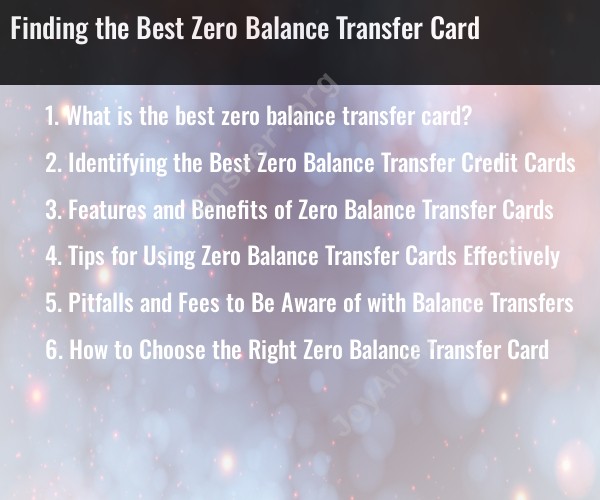What is the best zero balance transfer card?
The "best" zero balance transfer card can vary depending on your individual financial situation, credit score, and specific needs. It's important to consider several factors when evaluating and choosing a zero balance transfer card. Here are some key factors to consider:
Introductory 0% APR Period: Look for cards that offer a long introductory 0% APR period on balance transfers. This period can range from 6 months to 21 months or more. The longer the period, the more time you have to pay off your transferred balance without incurring interest charges.
Balance Transfer Fee: Many balance transfer cards charge a fee based on a percentage of the transferred balance. Consider cards with lower or no balance transfer fees. Some cards may offer promotional periods with no balance transfer fees for a limited time.
Regular APR: After the introductory period, the card's regular APR (Annual Percentage Rate) will apply to any remaining balance. Look for a card with a competitive and reasonable regular APR.
Credit Score Requirements: Check the credit score requirements for the card. Some balance transfer cards may require a good to excellent credit score for approval.
Credit Limit: Ensure that the credit limit on the card is sufficient to cover the amount you wish to transfer.
Additional Benefits: Some cards offer additional perks, such as cashback rewards, travel rewards, or no annual fees. Consider whether these benefits align with your financial goals.
Penalties and Terms: Carefully read the terms and conditions of the card, including any penalties for late payments or breaking the terms of the balance transfer agreement.
Credit Card Issuer: Consider choosing a card from a reputable and well-known credit card issuer. Major banks and financial institutions often offer a variety of balance transfer cards.
Your Financial Goals: Evaluate your financial goals and how the balance transfer card fits into your overall financial plan. Are you looking to pay off high-interest debt, consolidate multiple balances, or take advantage of a temporary interest-free period?
Compare Multiple Offers: To find the best option, compare multiple balance transfer card offers from different issuers. Online tools and comparison websites can help you make side-by-side comparisons.
It's important to note that the "best" balance transfer card for one person may not be the best for another, as individual financial situations and goals vary. Consider your specific needs, and choose a card that aligns with your ability to pay off the transferred balance during the introductory period and complements your overall financial strategy. Be sure to read the terms and conditions of the card carefully and use it responsibly.
Sure, here is a detailed explanation of the five topics you mentioned:
Identifying the Best Zero Balance Transfer Credit Cards
When searching for the best zero balance transfer credit cards, consider the following factors:
Length of the 0% APR period: The longer the 0% APR period, the more time you have to pay off your transferred balance without incurring interest.
Balance transfer fee: Balance transfer fees typically range from 3% to 5% of the transferred amount, so compare fees to find the most affordable option.
Eligibility requirements: Ensure you meet the credit score and income requirements to qualify for the card.
Additional benefits: Consider cards that offer additional benefits, such as travel rewards or cashback rewards.
Here are some of the top-rated zero balance transfer credit cards in the market:
Citi Simplicity® Card: Offers a 21-month 0% APR on balance transfers and a $0 balance transfer fee for the first 4 months.
Discover it® Balance Transfer: Provides a 15-month 0% APR on balance transfers and a 3% balance transfer fee.
Wells Fargo Reflect® Card: Features a 21-month 0% APR on balance transfers and a $0 balance transfer fee for the first 4 months.
Features and Benefits of Zero Balance Transfer Cards
Zero balance transfer credit cards offer several advantages:
Interest-free financing: The 0% APR period allows you to pay off your transferred balance without accumulating interest, saving you money.
Debt consolidation: You can consolidate multiple high-interest balances into a single card with a lower interest rate, simplifying your debt management.
Flexible payment options: Most cards offer flexible payment options, such as online payments, automatic payments, and mail payments.
Tips for Using Zero Balance Transfer Cards Effectively
To maximize the benefits of zero balance transfer cards, follow these tips:
Transfer high-interest balances: Prioritize transferring balances with the highest interest rates to save the most money.
Create a repayment plan: Develop a realistic repayment plan to pay off your transferred balance within the introductory 0% APR period.
Avoid adding new debt: Resist using the card for new purchases or adding balances to avoid accumulating additional debt.
Monitor your credit score: Check your credit score regularly to ensure your creditworthiness remains strong.
Pitfalls and Fees to Be Aware of with Balance Transfers
Before transferring balances, be aware of potential pitfalls and fees:
Balance transfer fees: Balance transfer fees can range from 3% to 5% of the transferred amount.
Hard credit inquiry: Applying for a new balance transfer card will result in a hard inquiry on your credit report, which may temporarily lower your credit score.
Interest charges after the introductory period: If you don't pay off your balance within the 0% APR period, you'll be charged interest on the remaining balance.
How to Choose the Right Zero Balance Transfer Card
To choose the right zero balance transfer card, consider these factors:
Your debt situation: Assess the amount of debt you want to transfer and the interest rates you're currently paying.
Your creditworthiness: Check your credit score and income to determine which cards you qualify for.
Your budget: Consider the balance transfer fee and the impact on your monthly payments.
Additional benefits: Evaluate any additional benefits offered by different cards, such as rewards programs or travel perks.
Compare offers carefully and choose the card that best aligns with your financial goals and needs. Remember to use balance transfer cards responsibly and avoid accumulating more debt.













